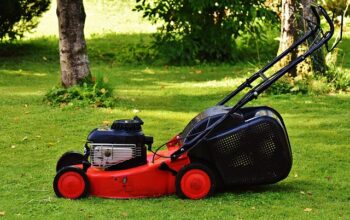Lawn Care and Landscaping involve strategic mulching and precise edging to maintain a healthy and attractive lawn. Mulching enriches the soil with organic matter, supports microbial activity, and aids in moisture retention, which are crucial for grass health and resilience against environmental stressors. Edging defines lawn boundaries, preventing turf encroachment and facilitating targeted watering to minimize waste. This combination leads to a more defined landscape, reduces soil erosion, and optimizes mulch benefits. Regular edging with appropriate tools helps maintain clean lines, enhances visual appeal, and inhibits weed growth. Twice-yearly edging, tailored to grass types and soil conditions, is recommended to uphold a professional-looking lawn throughout the seasons. By integrating these practices into your Lawn Care and Landscaping routine, you can achieve a well-maintained, sustainable, and visually appealing lawn that thrives with minimal environmental impact.
titling your lawn’s potential, “Mulching and Edging for Lawns” unveils a comprehensive approach to elevating your landscape’s aesthetic while bolstering its health. Delve into the transformative power of mulching through “The Science of Mulching,” where you’ll learn how this practice fortifies soil vitality and retains moisture, crucial for lush lawn growth. Then, refine your green space with precision by mastering edging techniques in “Mastering Edging Techniques.” Finally, synchronize both methods in “Integrating Mulching with Edging” to achieve a manicured lawn that stands out in your neighborhood, all within the realm of effective lawn care and landscaping.
- The Science of Mulching: Enhancing Soil Health and Conserving Moisture for Optimal Lawn Growth
- Mastering Edging Techniques: Defining Lawn Borders for a Manicured Appearance
- Integrating Mulching with Edging: Strategies for Efficient Lawn Maintenance and Aesthetic Upkeep
The Science of Mulching: Enhancing Soil Health and Conserving Moisture for Optimal Lawn Growth

Engaging in effective lawn care and landscaping practices, such as mulching, plays a pivotal role in nurturing a lush and vibrant lawn. The science of mulching extends beyond its aesthetic appeal; it actively enhances soil health by promoting beneficial microbial activity. Organic mulch, like grass clippings or wood chips, breaks down over time, adding valuable nutrients and improving the soil’s structure. This decomposition process also serves to conserve moisture within the soil, which is critical for optimal lawn growth. The mulch acts as a protective layer that reduces evaporation rates, allowing water to penetrate deeper into the soil where roots can access it more efficiently. As a result, lawns benefit from consistent moisture and a steady supply of organic matter, leading to improved turf health and resilience against environmental stressors.
Incorporating edging as part of your lawn care and landscaping regimen complements the benefits of mulching. Edges define the boundaries between your lawn and garden beds or walkways, preventing grass from encroaching on other areas and maintaining a clean, manicured appearance. This demarcation also facilitates more precise watering practices, ensuring that water reaches the intended area without excess runoff. Moreover, when combined with mulching, edging can help to minimize soil erosion and promote a healthier lawn by containing the mulch within its designated space, thereby maximizing its effectiveness. The synergy between these two practices not only enhances the visual appeal of your landscape but also supports the ecological balance beneath the turf, contributing to a more sustainable and thriving lawn environment.
Mastering Edging Techniques: Defining Lawn Borders for a Manicured Appearance

Engaging in masterful edging techniques is a cornerstone of maintaining a manicured lawn that stands out for its clean, well-defined boundaries. Effective edging not only delineates the grass from garden beds or walkways but also promotes healthier turf by preventing the encroachment of weeds and other invasive plants. Regularly edging your lawn is an integral part of lawn care and landscaping, as it ensures that the lawn’s edges are crisp and uniform, enhancing the overall aesthetics of your outdoor space. To achieve this, gardeners should use sharp edging tools and approach the task with precision, taking into account the type of border or edge material—whether it’s metal, plastic, stone, or brick—as this can influence the technique used. Edging can be performed manually with a spade or half-moon edger, or with powered tools for larger properties. Whichever method you choose, the goal is to create a clear demarcation that frames your lawn beautifully and allows for better grass growth and maintenance. Additionally, proper edging helps in directing water flow during irrigation or rainfall, preventing runoff and pooling that can lead to soil erosion or waterlogging in certain areas of the lawn. By incorporating edging as a regular part of your lawn care and landscaping regimen, you’ll cultivate a lawn that is not only visually striking but also healthy and resilient.
When it comes to maintaining a pristine edge, the choice of edger should be matched with the frequency of edging. A well-maintained edge can prevent grass from overgrowing into the flowerbeds or walkways, which is not only a matter of aesthetics but also of lawn care and landscaping best practices. It’s advisable to edge your lawn at least twice a year—once in early spring and again in late fall—to maintain clean lines and manage growth effectively. This consistent approach to edging can make a significant difference in how your lawn looks throughout the seasons, providing a clear transition between the turf and other landscape features. Moreover, when edging, it’s important to be mindful of the grass types and soil conditions, as these factors can affect how aggressive your edging should be to avoid damaging the lawn. With careful planning and regular maintenance, your lawn will be the envy of the neighborhood, reflecting a well-groomed and polished outdoor environment that is the hallmark of meticulous lawn care and landscaping.
Integrating Mulching with Edging: Strategies for Efficient Lawn Maintenance and Aesthetic Upkeep

Lawn care and landscaping professionals often emphasize the importance of integrating mulching with edging to maintain a healthy and well-manicured lawn. Mulching serves as a vital practice for soil enrichment and moisture retention, which can significantly enhance grass growth and resilience against weeds and pests. By applying a generous layer of organic mulch around the base of plants and along garden beds, homeowners can provide nutrients that gradually seep into the soil, offering a steady supply of essential elements like nitrogen. This not only improves soil quality but also aids in regulating soil temperature and conserving moisture, reducing the need for frequent watering.
Edging complements mulching by creating clear boundaries between the lawn and garden beds or pathways. A well-defined edge not only contributes to the aesthetic appeal of the landscape but also prevents grass from encroaching onto walkways or driveways. This separation is crucial for effective maintenance, as it allows for targeted edging and mulching efforts that are more efficient and less time-consuming. When edging is sharp and distinct, mulch can be placed precisely where it’s needed most, minimizing waste and ensuring that the beneficial materials directly benefit the intended areas. Additionally, clean edges make mowing the lawn easier, as lawnmowers can glide over a defined edge without getting stuck or damaging bordering surfaces. This integration of mulching with edging not only enhances the visual appeal of your lawn but also supports the health and vitality of your landscaping investments.
Effective lawn care is pivotal for achieving a lush, vibrant landscape. The science of mulching plays a critical role in enhancing soil health and conserving moisture, fostering optimal growth for your lawn. Mastering edging techniques is equally essential for defining clear, manicured borders that elevate the aesthetic appeal of your outdoor spaces. By integrating these two practices, homeowners can maintain both the health and the beauty of their lawns with finesse. With careful attention to mulching and edging, your lawn will not only thrive but also serve as a testament to your commitment to landscaping excellence. Implementing these strategies consistently ensures your lawn remains a point of pride and a tranquil oasis in your surroundings.




